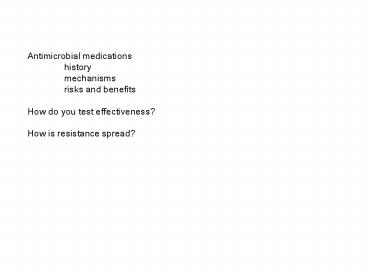Antimicrobial medications - PowerPoint PPT Presentation
1 / 28
Title:
Antimicrobial medications
Description:
What are adverse effects? ... Inhibit cell division or metabolism Neurotoxins for helminths See Table 21.4 New strategies New targets for antimicrobials? – PowerPoint PPT presentation
Number of Views:169
Avg rating:3.0/5.0
Title: Antimicrobial medications
1
Antimicrobial medications history mechanisms ri
sks and benefits How do you test
effectiveness? How is resistance spread?
2
First steps chemotherapeutics drugs that killed
the microbe but not the patient! Salvarsan
(Ehrlich arsenic syphilis) Prontosil (Domagk
sulfa drugs streptococcus) Antibiotics
produced by microorganisms Fleming
penicillin Waksman streptomycin More recently,
compounds have been modified
3
(No Transcript)
4
Features of antimicrobials (why do most come from
soil microbes?) Selective toxicity Type of
action bactericidal bacteriostatic Depends of
stage of growth of microbe sensitivity to
immune mechanisms Spectrum- broad or
narrow broad can be prescribed quickly but
kill normal flora, too
5
Metabolism distribution stability Must drug be
injected? How long does drug persist in
system? Can drug cross blood-brain barrier? Does
patient have normal liver and kidney function?
6
What are adverse effects? Hypersensitivity Toxic
effects aminoglycosides chloramphenicol Suppre
ssion of normal flora opportunistic
infections Efficacy Cost
7
How do these drugs work?
8
Inhibitors of bacterial cell wall synthesis
- high therapeutic index act on bacteria but not
eukaryotes - ?-lactam drugs are enzyme inhibitors
- Have range of activity in nature and in synthetic
forms - Vancomycin inhibits peptidoglycan synthesis
- Bacitracin- different mechanism highly toxic
9
Penicillin derivatives and their features
10
Inhibition of protein synthesis
11
These are pretty toxic Aminoglycosides- kidney
damage, deafness Neomycin cant be taken
internally Tetracyclines can discolor teeth in
children Chloramphenicol- aplastic
anemia Macrolides (erythromycin,
azithromycin)- bacteriostatic Newer drugs are
less toxic Tend to be broad spectrum
12
Other targets nucleic acid synthesis
(fluoroquinolones, rifamycins) metabolic
pathways, etc. folic acid (humans lack this
pathway, therefore these enzymes) trimethoprim,
sulfanolamides cell membranes (polymixin
B) specialty drugs- antituberculars slow
growth waxy coat intracellular
13
How do you know if a particular drug will be
effective? Minimum inhibitory concentration
(MIC) Minimum bactericidal concentration
(MBC) (giving combinations is risky for
toxicity, hypersensitivity, drug resistance)
14
(No Transcript)
15
Kirby-Bauer is quicker and easier
16
E test will give dose information
17
Mechanisms of drug resistance,
Mutation or gene transfer?
18
It doesnt take long for microbes to
become drug-resistant!
19
many resistance genes are on plasmids
20
Important resistant organisms Vancomycin-resistan
t enterococci MRSA (methicillin-resistant S.
aureus) Penicillin-resistant S.
pneumoniae Multiple-drug-resistant M.
tuberculosis
21
How can we prevent the formation of
drug- resistant microbes? Health workers
prescribe appropriately! Patients take drugs as
prescribed! Dont take antibacterials for viral
infections! Should antibacterials be easily
available? Should we use them in animal feed?
22
Not all infections are caused by bacteria. What
are appropriate treatments for viruses fungi pr
otozoans helminths
23
Viruses are challenging because many have
no unique target structure If immune system
doesnt control infection Prevent viral
replication Prevent viral polymerase
activity Prevent assembly and release of new
virions
24
(No Transcript)
25
Targets of antifungal drugs
26
(No Transcript)
27
Treating protozoan and helminthic
diseases Inhibit cell division or
metabolism Neurotoxins for helminths See Table
21.4
28
New strategies New targets for
antimicrobials? Interfere with resistance
mechanisms? Enhance host defenses? New vaccine
concepts?































